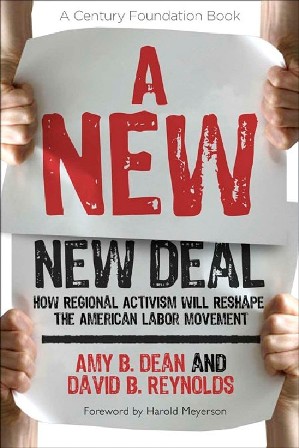
“A New New Deal: How Regional Activism Will Reshape The American Labor Movement”
By Amy B. Dean and David B. Reynolds
Cornell University Press, 2009, 275 pp
The room was full. Union members and labor supporters were noshing vegetables and dip and other finger food delights at the Pittsburgh convention center, waiting to hear Amy Dean, former president of the South Bay Labor Council and co-author of “A New New Deal: How Regional Activism Will Reshape The American Labor Movement.” There would be two other speakers there, the new AFL-CIO president, Richard Trumka, and secretary-treasurer, Liz Shuler.
This took place during the AFL-CIO’s convention last September. It was a book-signing and reception for perhaps one of the most unique books to be published in 2009 and its co-author. As soon as the boxes of books opened the crowd surged forward, hands extended, waiting to grab this “manna from heaven,” as one labor journalist said. “We’re hungry and there is a desert out there.”
At a time when the loosely formed labor-community coalition has won important battles locally and nationally, from kids’ health care on a state and regional level to the election of President Barack Obama, there haven’t been too many books written on how to win progressive and sustained victories from a labor-community coalition point of view. That’s what makes “A New New Deal” unique.
Amy Dean and her co-author David Reynolds explore in detail the rise of regional labor-community coalitions since the mid-1990s, what they are accomplishing, the strategy behind them and the shortcomings. Reynolds is labor extension coordinator at the Labor Studies Center of Wayne State University in Detroit.
Starting with the experience of Dean and the South Bay Labor Council, based in San Jose, Calif., and the Los Angeles County Labor Federation under the leadership of the late Miguel Contreras, the authors explain three necessary factors to build power for working people.
To begin with, a strong and active central labor council is essential, the core of any regional labor/community coalition. Starting from there, the authors introduce “three legs of regional power building”: a regional policy agenda with “think-and-act tanks” associated with the labor movement, “deep coalitions,” and “aggressive political action.” These three legs are interrelated and necessary to moving toward a pro-people agenda and away from a solely business-oriented, for-profit-only agenda, the authors say.
Dean and Reynolds use examples from across the country to make the point that each area has different variables, declining or ascending economies, different grassroots organizing histories, demographics and union densities, but the three components of regional power-building are a constant.
They place this power-building strategy in the context of regional economies. And this, in my opinion, is the most mind-expanding part of the book: thinking about the economics of a region instead of being limited to the political boundaries of cities, suburbs and towns.
Dean and Reynolds argue that corporations have many regional associations that help get them in at the ground floor on regional planning, from land use to housing and transportation planning, that deeply affects working people, union members, communities of color, low-income and upwardly mobile professionals. However these interests are rarely represented from the get-go of the planning and decision making process. So if a large housing complex is to be developed, how do you leverage grassroots organizing to win affordable housing? Dean and Reynolds say: by developing research/policy advocates, coalition building and political action. The main thing, the authors say, is to think broadly about economic development. Jobs, yes, but quality of life issues too, health care, land use, environmental protection, schools and transportation. Union organizing and solidarity campaigns are also part of the coalition work.
For building deep coalitions, the authors point to many kinds of alliances with labor at their core. Broadly, they outline labor-community, labor-minority-immigrant and labor-interfaith alliances as key in coalition building based on shared economic and social justice interests. The authors also discuss civic institutions and businesses that may be part of a regional power-building coalition. After all, they say, the regional business community is not monolithic.
Regional power building, the authors argue, is one way of organizing. And it is not in competition, but complementary to national labor and community organizing strategies. As a matter of fact, they say, building regionally helps deepen the bench, so to speak, for labor and community coalitions on a national scale. It helps to make the “change” that people sought to make on a national level with the election of Barack Obama to the White House, on a regional and statewide level. That’s a necessity in order to sustain any type of progressive reform agenda.
And that makes this book a must-read for any serious advocate for union and worker rights and social justice.










